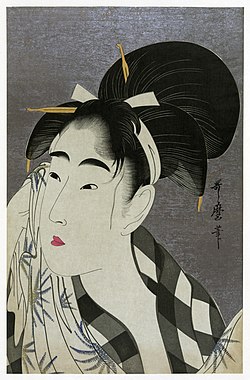Top Qs
Timeline
Chat
Perspective
Ōkubi-e
Japanese woodblock prints From Wikipedia, the free encyclopedia
Remove ads
An ōkubi-e (Japanese: 大首絵) is a Japanese portrait print or painting in the ukiyo-e genre showing only the head or the head and upper torso.[1] Katsukawa Shunkō I (1743–1812) is generally credited with producing the first ōkubi-e. He, along with Katsukawa Shunshō, designed ōkubi-e of male kabuki actors. In the early-1790s, Utamaro designed the first ōkubi-e of beautiful women (bijin-ga ōkubi-e). The shogunate authorities banned ōkubi-e in 1800, but the ban was lifted after eight years.
Remove ads
Gallery
- Ōkubi-e of kabuki actor Matsumoto Kōshirō IV as Tsurunosuke, a woodblock print by Katsukawa Shunkō I
- Woodblock print by Utagawa Kunimasa of kabuki actor Ichikawa Ebizō in a shibaraku role, 1796
- Ichikawa Yaozo III as Umeōmaru, woodblock print by Utagawa Kunimasa, 1796
- Nakazō Nakamura II as Edobee, woodblock print by Sharaku, 1794
- Print by Kitagawa Utamaro
- Woman Wiping Sweat, woodblock print by Utamaro, 1798
- Portrait of Hagiwara Sakutarō, woodblock print by Onchi Kōshirō, 1943
Remove ads
References
Further reading
Wikiwand - on
Seamless Wikipedia browsing. On steroids.
Remove ads






